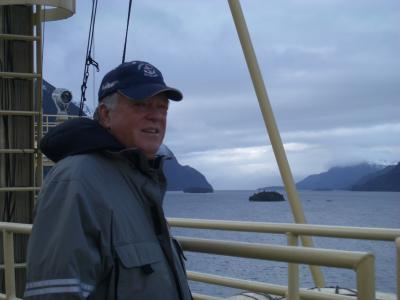"There's a longstanding debate about how rapidly glaciation progressed in Antarctica," said Sophie Warny, a Louisiana State University geologist who specializes in palynology (the study of fossilized pollen and spores) and led the palynological reconstruction. "We found that the fossil record was unambiguous; glacial expansion in the Antarctic Peninsula was a long, gradual process that was influenced by atmospheric, tectonic and oceanographic changes."
Warny, her students and colleague Rosemary Askin were able to ascertain the exact species of plants that existed on the peninsula over the past 36 million years after a painstaking, three-year examination of thousands of individual grains of pollen that were preserved in muddy sediments beneath the sea floor just off the coast.
"The pollen record in the sedimentary layers was beautiful, both in its richness and depth," Warny said. "It allowed us to construct a detailed picture of the rapid decline of the forests during the late Eocene -- about 35 million years ago -- and the widespread glaciation that took place in the middle Miocene -- about 13 million years ago."
Obtaining the sedimentary samples wasn't easy. The muddy treasure trove was locked away beneath almost 100 feet of dense sedimentary rock. It was also off the coast of the peninsula in shallow waters that are covered by ice most of the year and beset by icebergs the rest. Anderson, a veteran of more than 25 research expeditions to Antarctica, and colleagues spent more than a decade building a case for the funding to outfit an icebreaker with the right kind of drilling equipment to bore through the rock.

Rice University scientist John Anderson discusses what researchers have learned from studying the first direct and detailed climate record from the continental shelves surrounding Antarctica, and he describes the years of effort that went into obtaining it.
(Photo Credit: B. Martin/Rice University)
In 2002, the National Science Foundation (NSF) funded the project, which was dubbed SHALDRIL. Three years later, the NSF research vessel Nathaniel B. Palmer left on the first of two drilling cruises.
"It was the worst ice year that any of us could remember," Anderson said. "We'd spend most of a day lowering drill string to the ocean floor only to pull it back up to get out of the way of approaching icebergs."
The next year was little better, but the SHALDRIL team managed to obtain enough core samples to cover the past 36 million years, thanks to the logistical planning of marine geologist Julia Wellner and to the skill of the drilling crew. By end of the second season, Anderson said, the crew could drill as much as a meter every five minutes.
Reconstructing a detailed climate record from the sample was another Herculean task. In addition to the three-year palynological analysis at LSU, University of Southampton palaeoceanographer Steven Bohaty led an effort to nail down the precise age of the various sediments in each core sample. Wellner, now at the University of Houston, examined the characteristics of the sediments to determine whether they formed below an ice sheet, in open marine conditions or in a combined glacial-marine setting. Other members of the team had to count, categorize and even examine the surface texture of thousands of sand grains that were preserved in the sediments. Gradually, the team was able to piece together a history of how much of the peninsula was covered by glaciers throughout the past 36 million years.
"SHALDRIL gave us the first reliable age constraints on the timing of ice sheet advance across the northern peninsula," Anderson said. "The rich mosaic of organic and geologic material that we found in the sedimentary record has given us a much clearer picture of the climatic history of the Antarctic Peninsula. This type of record is invaluable as we struggle to place in context the rapid changes that we see taking place in the peninsula today."

Researchers ascertained the exact species of plants that existed on the Antarctic Peninsula over the past 36 million years during a three-year examination of thousands of grains of fossilized pollen, including this grain from the tree Nothofagus fusca.
(Photo Credit: S. Warny/LSU)

This is Rice University oceanographer John Anderson aboard the Nathaniel B. Palmer.
(Photo Credit: Rice University)
Source: Rice University